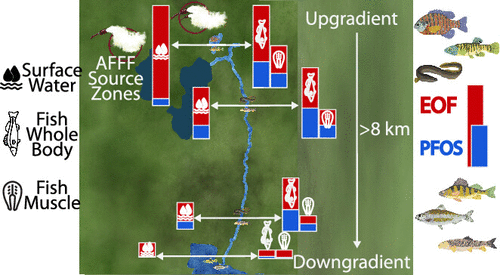Most monitoring programs next to large per- and polyfluoroalkyl substances (PFAS) sources focus on drinking water contamination near source zones. However, less is understood about how these sources affect downgradient hydrological systems and food webs. Here, we report paired PFAS measurements in water, sediment, and aquatic biota along a hydrological gradient away from source zones contaminated by the use of legacy aqueous film-forming foam (AFFF) manufactured using electrochemical fluorination. Clustering analysis indicates that the PFAS composition characteristic of AFFF is detectable in water and fishes >8 km from the source. Concentrations of 38 targeted PFAS and extractable organofluorine (EOF) decreased in fishes downgradient of the AFFF-contaminated source zones. However, PFAS concentrations remained above consumption limits at all locations within the affected watershed. Perfluoroalkyl sulfonamide precursors accounted for approximately half of targeted PFAS in fish tissues, which explain >90% of EOF across all sampling locations. Suspect screening analyses revealed the presence of a polyfluoroketone pharmaceutical in fish species, and a fluorinated agrochemical in water that likely does not accumulate in biological tissues, suggesting the presence of diffuse sources such as septic system and agrochemical inputs throughout the watershed in addition to AFFF contamination. Based on these results, monitoring programs that consider all hydrologically connected regions within watersheds affected by large PFAS sources would help ensure public health protection.



General audience article: https://phys.org/news/2024-10-pfas-fish-contamination-sources.html